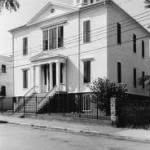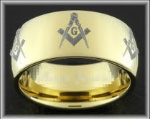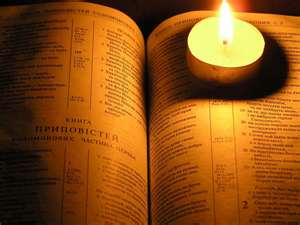Archive for the 'Freemasonry' Category
 The Beginnings of the Order of Freemasonry
The Beginnings of the Order of Freemasonry
Recommend. This is an article written by Mike Fox, Owner Fox Jewelry, and the leading marketer of Masonic Rings. I have often been asked to elaborate a bit about the beginnings of Freemasonry.
The order is believed to have arisen from the English and Scottish fraternities of practicing stonemasons and cathedral builders back in the early Middle Ages. Traces of the society have also been discovered as far back the 14th century. Because some documents of the order outline the sciences of masonry and geometry from Egypt, Babylon, and Palestine to England and France, some historians of Masonry claim that the group has roots in ancient times.
The formation of the English Grand Lodge in London (1717) was the start of the widespread distribution of speculative Freemasonry, the present-day fraternal order, that is not exclusively for practicing stonemasons. The six lodges in England in 1700 grew to about thirty by 1723. There exists a parallel formation in Scotland and Ireland; however some lodges remained unaffiliated and open just too practicing masons. By the end of the 18th century, there were Masonic lodges in most European nations as well as in lots of other parts of the world as well.
The first Masonic Hall or lodge in the United States was established in 1755 in Philadelphia; Benjamin Franklin was actually a member. Many of the leaders of the American Revolution, including John Hancock and Paul Revere, were members of St. Andrew’s Lodge in Boston. George Washington became a Mason in 1752. Brother Marie Joseph Paul Yves Roch Gilbert du Montier, more commonly known as the Marquis de Lafayette presented George Washington with the apron that he wore while laying the Cornerstone of the National Capitol in 1898. The apron is now in the Collection of the Grand Lodge, on deposit with the Masonic Library and Museum of Pennsylvania.
During the time of the Revolution most of the American lodges broke from the their English and Scottish antecedents. Freemasonry has remained to be essentially significant in politics; 13 Presidents have been Masons, and at the same time quite a large number of the members of Congress have belonged to Masonic lodges.
I hope that you have found the information above to be useful and informative. Please feel free to make comments of make suggestions. I hope that when you are in the market for a quality Masonic ring , a Past Master ring or any other Fraternal ring such as a Knights of Columbus Ring or Eastern Star Ring, you keep www.foxjewelry.net in mind when making your selection. If you have additional questions, please feel free to email me at: [email protected] or call me at 712-239-6155.
www.facebook.com/masonicringsbyfox
Follow us on Twitter: @MasonicRings
Article written by: Mike Fox, Owner of Fox Jewelry, located in Sioux City, IA
Th
 e oldest Masonic Hall in the United States is the Richmond Randolph Lodge #19 located in none other than the capitol of the confederacy; Richmond Virginia. The cornerstone was laid in 1785 and the Lodge was chartered in 1787. The lodge is noted as the oldest continuously operating Masonic facility in the Western Hemisphere.
e oldest Masonic Hall in the United States is the Richmond Randolph Lodge #19 located in none other than the capitol of the confederacy; Richmond Virginia. The cornerstone was laid in 1785 and the Lodge was chartered in 1787. The lodge is noted as the oldest continuously operating Masonic facility in the Western Hemisphere.
The building itself is a perfect cube and the lot on which it stands is a perfect square or cube itself, a symbol that all Mason’s will understand. Though fully intended to be a two story facility; when first built, the building was only one-story as funds from the lottery money used to build the structure became exhausted. Worked stopped after the first story built of brick was finished. Several years later; the second story made of wood was completed. In those days it was the custom to resort to lotteries for the purpose of raising funds for such facilities. In 1785, the Legislature of Virginia passed an act authorizing “the Society of Free Masons of the City of Richmond” to raise, under the direction of the common hall of Richmond, a sum of money not exceeding 1,500 pounds, for the purpose of erecting and completing a Free Masons’ hall.
There is probably no other Masonic building in the United States which has been visited by as many influential men throughout history. The late King Edward of England, then the Prince of Wale, was among the visitors, as was also General George Washington, General Lafayette and his son, George Washington Lafayette, all of whom were formally elected to honorary membership in Richmond-Randolph Lodge.
I hope that you have found the above article interesting. Please feel free to offer your comments. When you are in the market for a quality Masonic ring or other Fraternal rings, please keep Fox Jewelry in mind when making your selection. If you have additional questions, please feel free to email me at: [email protected] or call me at 712-239-6155.
www.facebook.com/masonicringsbyfox
Follow us on Twitter: @MasonicRings
Written by: Mike Fox, owner of Fox Jewelry located in Sioux City, IA.
 This is going to be the beginning of an interesting discussion on the above and not one necessarily shared by my compatriots in the Masonic ring jewelry business; especially those that spend a lot of money on marketing diamonds.
This is going to be the beginning of an interesting discussion on the above and not one necessarily shared by my compatriots in the Masonic ring jewelry business; especially those that spend a lot of money on marketing diamonds.
To get started with this, I would like to relate to you a discussion that I recently had with a person who joined our group at the local coffee shop in Sioux City this week. As I was standing behind her waiting for my turn to order my double shot of espresso, it was fairly obvious that she wasn’t a “local”. The hiking boots, the brown khakis, and the environmentally green winter jacket were a dead giveaway. She had what I would call the “Boulder Colorado” look that is not all that bad if I must admit. That being said; she was a wonderful guest at our morning coffee and hope that she joins us again as she was truly quite interesting. The rest of the group was comprised of a few of my Masonic brothers, as well as others. There was quite a mixture of Democrats and Republicans or what I would refer to as Liberals and Conservatives. Without asking, I would have guessed the young lady (at my age; anyone under 50 is young) was a Liberal and I hope that my blog does not offend her if I am incorrect. I have great respect for both political and lifestyle persuasions. Matter of fact; some of my best friends and relatives are liberals and I love them all. My biggest issue with them is which trash receptacle is supposed to get the paper, which one the plastics and so on. You get my drift.
We began a discussion of whether or not a person could be considered a Liberal and a Conservative at the same time. I indicated that I was a perfect example of that kind of person. Without getting too political here, I would consider somewhere in between. I have a very liberal viewpoint of the world, its people and their lifestyles and beliefs. After all, who am I to judge? I am very accepting of other’s viewpoints; especially when we really do not know the answer to all things. On the other hand, in my past life, I would have been considered a “suit” having worn one of them for roughly 30 years while in the corporate world. It is in that “past life” that I developed my own ideas on finance, business, economics and value.
Now on to the discussion as to whether I would recommend a diamond or Moissanite in your Masonic ring or other fraternal rings.
First of all, I owe it to you to give you a description of Moissanite. Provide below is a link to the Charles & Colvard site that explains the origins of Moissanite and its rare and unique qualities. If you don’t want to bother with the link, here is an explanation taken directly from the Charles & Colvard website.
“First uncovered in a meteorite and impossibly rare on earth, Charles & Colvard® patented the innovative high-tech process that creates this brilliant jewel into one of the hardest gemstones on earth. More durable than sapphire, ruby or emerald; Moissanite’s beauty will last for generations.
The World’s Most Brilliant Gem™
Why do so many women prefer Charles & Colvard Created Moissanite to other colorless gems? It outshines any other gem… side by side, there’s no comparison.
With a refractive index of 2.65-2.69, Moissanite exhibits more brilliance than diamond. And thanks to a dispersion that’s 2.4 times that of diamond, Moissanite bends light into mesmerizing rainbow flashes of fire… over two times more than diamond, ruby, emerald or sapphire. By day and by night, Moissanite simply dances with light.
And, carat for carat, no gem adds more beauty to your life for less of an investment. When you choose Moissanite jewelry, you don’t have to compromise quality, size, or style to fit your budget.
Born in the Stars
Moissanite is inspired by ancient stardust. Fifty thousand years ago, a meteorite flashed across the sky and landed in Arizona, creating Meteor Crater, a vast hole in the earth’s surface 570 feet deep and nearly a mile across, along with scattering meteorite fragments across the desert. Some landed a few miles away in nearby Canyon Diablo where in 1893, Nobel Prize-winning scientist Dr. Henri Moissan discovered tiny sparkling crystals of silicon carbide. This new gem was later named Moissanite in his honor by Tiffany & Co. gem expert and mineralogist George Kunz. Naturally-occurring Moissanite is incredibly rare. Just a handful of crystals have been discovered, always in extreme environments like meteorites, upper mantle rock, or even as tiny inclusions inside diamonds.
A century later, the first large, gem quality crystals were successfully grown in a high-tech North Carolina lab. Charles & Colvard introduced the world to the brilliance and fire of gem-quality Moissanite in 1998 and today remains the sole source of created Moissanite gemstones.”
Of course, we all know the definition of a diamond.
Now after knowing a little bit about my background and being a bit of a conservative in my own personal spending habits, it is hard for me not to advise you to put a Moissanite in your Masonic ring. Side by side, the Moissanite is going to stand out as being the clear choice in my opinion unless you are going to compare it to a near perfect diamond. If that is the case, be prepared to spend a whole lot of money on the diamond in comparison to the cost of a fine Moissanite stone for your Freemason’s ring. Keep in mind that even as hard as the Moissanite stone is, it can break under certain conditions but a diamond can do that as well. In my opinion, the Moissanite is a better choice for us fiscally conservative types as well as a whole bunch of my liberal friends. Some of you are going to insist on a genuine diamond and I respect that decision. For the rest of us that want more bang for their buck, I am going with Moissanite for my Masonic ring.
I hope that I have been able to answer your questions and hope that when you are in the market for a quality Masonic ring or other Fraternal rings you keep Fox Jewelry in mind when making your selection. If you have additional questions, please feel free to email me at: [email protected] or [email protected] or call me at 712-239-6155 and ask for Mike Fox.
www.facebook.com/masonicringsbyfox
Follow us on Twitter: @MasonicRings
www.foxjewelry.net
Open or Solid Back Masonic Ringhttp://www.masonicjewelryblog.net/
www.facebook.com/masonicringsbyfox
Follow us on Twitter: @MasonicRings
www.foxjewelry.net
 I am often asked; what is the difference between an open and a closed back or solid back Masonic ring and which is my preference in the Masonic Rings that we sell.
I am often asked; what is the difference between an open and a closed back or solid back Masonic ring and which is my preference in the Masonic Rings that we sell.
This is probably one of the most asked questions that I receive. It seems simple to answer but it is difficult to explain.
It is probably easiest to begin by having explanation of the difference.
I know that you have all seen an open back ring. In an open back Masonic ring; that has a stone in it such as the blue spinel, black onyx, or synthetic ruby, you can actually see the back of the stone when you look at the inside of the ring. In an open back ring that does not have a stone in it, there is a void behind the head of the ring.
In a closed back or solid back Masonic ring, the void behind the stone or behind the head of the ring is filled in with gold (in a quality ring such as the ones we sell). The inside of the ring will be completely filled in with gold and will be smooth all the way around the inside of the ring much like a wedding ring. In some of the lesser expensive Masonic rings or other fraternal jewelry, the void behind the ring is sometimes filled in with another alloy such as lead or silver. Adding a different alloy other than gold to fill in the back of the ring serves the same purpose, just don’t get tricked into believing that you are purchasing a solid back ring that is filled in with gold.
My preference is a solid back ring. In my opinion, they are more comfortable to wear, are a bit heavier, stronger and more durable than an open back ring. We have all seen rings that are bent out of shape. Chances are that it was not a solid back ring. They are also easier to keep clean as an open back ring tends to collect soap scum, dust and other material. If you are a person that tends to work with their hands in an environment whereby the ring is going to be subject to the above, I would definitely recommend the solid back or closed back ring. The ring is going to withstand the test of time and be around a lot longer than the open back ring.
Of course there is a catch to everything; therefore the next question. Do you have budget constraints? Of course we all do; so at the end of the day, that will probably be the deciding factor. I will tell you one thing; however, if your budget allows either to have a 14K gold Masonic ring or a solid back ring, I would forego the 14K gold ring and go with a solid back ring.
I hope that I have been able to answer your questions and hope that when you are in the market for a quality Masonic ring or other Fraternal rings you keep in mind foxjewelry when making your selection. If you have additional questions, please feel free to email me at: [email protected] or call me at 712-239-6155.
This is an article written by Mike Fox, Owner Fox Jewelry, the leading marketer of Masonic Rings and other Masonic and Fraternal Jewelry.
http://www.masonicjewelryblog.net/
www.facebook.com/masonicringsbyfox
Follow us on Twitter: @MasonicRings
www.foxjewelry.net
I am often a sked about the difference between the different qualities of gold and which is my preference in the Masonic Rings that I sell.
sked about the difference between the different qualities of gold and which is my preference in the Masonic Rings that I sell.
It is probably easiest to start out with an explanation of the difference.
24K gold is the purest and is normally what I would refer to as “investment gold”. Typically 24K gold is not ideal for jewelry because it is too soft; therefore it damages easily and would be considered by many as too heavy to wear for jewelry.
22KT gold is used by dentists as it is easy shape and fit, but a small addition of an alloy makes it much harder wearing, but no so hard that it wears down the opposing teeth.
As you continue to reduce the amount of gold in your piece of jewelry, other alloys are mixed with the gold prior to the gold being poured into the mold. Most men’s or women’s rings are made of 14K or 10K gold. Some are made of 9K as they are hard-wearing and fine for mass-market jewelry.
Silver is usually the preferred metal to “dilute” gold with as it’s also a precious metal and is relatively cheap, and nickel is even cheaper but can provoke allergic reactions. Platinum and palladium is increasingly used but it’s harder to work with and is actually more expensive than the gold it replaces.
Lesser grades of gold such as 9K tends to shy away from using anything of value to form an alloy and may be mixed with brass, copper, tin, zinc, iron, aluminum or even with other cheaper alloys. Often these cheaper metals are added to finer quality jewelry in order to achieve a particular color. Silver and bismuth, for example, gives “black” gold.
Thus explains the difference between the different qualities of gold and provides an explanation when you hear that 10K gold is more durable and harder than a 14K gold ring. The 10K gold ring is diluted with other alloys that are stronger, harder and more durable; making the ring more resistant to scratching, denting, bending etc.
When I am asked by my customers which quality I recommend, I ask two questions.
First of all, if you are going to be wearing the ring on a daily basis; what is your profession? If you are a person that tends to work with their hands out in the elements or if the ring is going to be exposed to harsh chemicals etc; I would recommend a 10K ring. If you are a “paper shuffler or desk jockey” you have the choice because a 14K gold ring will withstand the wear.
The next question that I ask is: Do you have budget constraints? Of course we all do,but don’t break the bank just to have a 14K ring. A 14K Masonic Ring or other fraternal ring is going to appear a little more yellow because of the color of the gold but most people that are going to see your ring probably are not going to be able to see the difference if you keep your ring clean and polished.
I hope that I have been able to answer your questions and hope that when you are in the market for a quality Masonic ring or other Fraternal rings such as a Knights of Columbus Ring or Eastern Star Ring, you keep www.foxjewelry.net in mind when making your selection. If you have additional questions, please feel free to email me at: [email protected] or call me at 712-239-6155.
 The Significance of the Holy Bible in the Masonic Blue Lodge
The Significance of the Holy Bible in the Masonic Blue Lodge
In most Christian societies the furnishings of the lodge normally consists of the Holy Bible, and the Square and Compass; although Freemasonry teaches us that all men are free to follow the religious teachings or doctrine of their choice. A candidate may choose his own personal bible when taking their obligation. In American Lodges the Holy Bible remains open on the altar as well.
Whether you are searching for a Masonic Ring or several Masonic Rings, please visit our site at:
www.facebook.com/masonicringsbyfox
Follow us on Twitter: @MasonicRings
www.foxjewelry.net
The Masonic Trowel
http://foxjewelry.net.co/The_Masonic_Trowel/t54/articles.html
The Working Tools of a Freemason, The Masonic Gavel
http://foxjewelry.net.co/The_Masonic_Gavel/t53/articles.html?osCsid=8f3abe930da67025387b754befa6361f